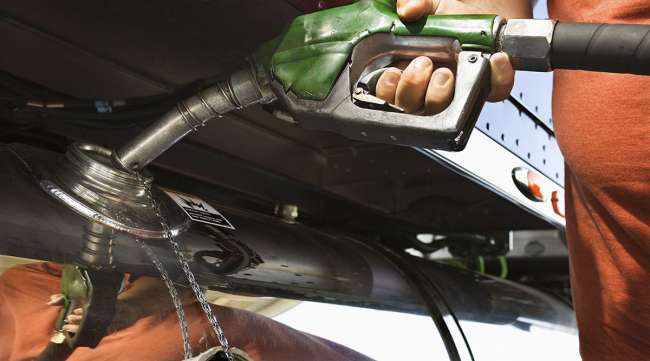Staff Reporter
Diesel Nudges Up 0.4¢ to $2.39 a Gallon for First Rise This Year

[Stay on top of transportation news: Get TTNews in your inbox.]
The nationwide average price of diesel fuel increased by about half a penny, the U.S. Energy Information Administration reported May 26, ending a string of 19 consecutive weekly price decreases in 2020.
The price of diesel rose 0.4 cent to $2.390 a gallon from $ 2.386 the previous week. Trucking’s main fuel costs 76.1 cents a gallon less than it did a year ago.
Diesel began the year at $3.079 and had dropped each successive week until now.

How can trucking companies adjust to ensure that essential freight keeps moving while protecting their workers from coronavirus? Host Seth Clevenger speaks with Lilli Chiu of Hub International and Dave Cox of Polaris Transportation. Hear a snippet, above, and get the full program by going to RoadSigns.TTNews.com.
Every region across the country except two had price increases. The Central Atlantic saw diesel prices decline by 0.1 cent to $2.666 a gallon, and the Gulf Coast saw no change at $2.175 a gallon.
The West Coast absent California saw the most significant increase at 1.8 cents. The price in California rose 1.1 cents to $3.182 a gallon. The Golden State still has the most expensive diesel at $3.182 a gallon.
Meanwhile, the average price of a gallon of gasoline increased 8.2 cents to $1.960 a gallon. Gasoline now costs 86.2 cents per gallon less than it did a year ago. Every region across the country saw a rise in gasoline prices.
The Rocky Mountain region experienced the most significant increase at 17.1 cents to $1.991 a gallon. The Lower Atlantic region came in a distant second at a 9.5-cent increase to $1.787 a gallon. The smallest increase came in the Central Atlantic region, which saw prices go up 4.5 cents to $2.082 a gallon.

Kloza
“We had a hell of a drop, which resulted in probably the lowest demand we’ve seen for gasoline since John Kennedy was president,” Tom Kloza, co-founder and global head of energy analysis for Oil Price Information, told Transport Topics. “We’ve had more of a drop on the gasoline consumption than we did on diesel consumption. Diesel consumption kind of lagged.”
Kloza added gasoline demand started picking up while diesel demand suffered when it came to late April. He noted that is somewhat typical when fuel markets get into May, as it is generally considered the weakest month for diesel internationally.
“There was a four-week average number that was published by the EIA,” Kloza said. “It was the lowest four-week number of the 21st century.”
In fact, he noted that four-week figures can be instructive and can sometimes paint a more complete picture than weekly numbers.
“People were probably prematurely heralding a return to normalcy after COVID,” Kloza said. “I am in the camp that says COVID-19 wants us for the rest of the year. Maybe not to the extent it is today. But it’s going to haunt us in a lot of markets.”
He suggested that U.S. refiners may not be in a hurry to begin ramping up production capacity, as they already have the largest-ever supplies of gasoline for this time of year and could have diesel surpluses into the second half of the year.

Ragan
Melton Truck Lines CFO Robert Ragan told TT that while the lower fuel costs are beneficial to carriers and shippers, they also are an indicator of larger problems in the greater economy that can hurt the industry longer term — especially trucking companies that serve the energy sector.
“I think what both sides want, shippers and carriers, is more stability in the fuel market prices,” Ragan said. “It’s hard to budget when fuel prices are swinging wildly one way or another. The rapid decline has helped the shippers out now, but from a broader perspective, the extremely low oil prices — where the futures market even went negative for a while — that’s not good for our industry as far as certain carriers that service the oil and gas industry.”
Want more news? Listen to today's daily briefing:




